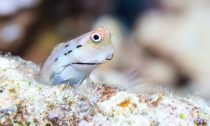
The foundation of massive, flashy and dazzling coral reefs may be a group of fish almost too small to see. New research suggests a group of fish species called cryptobenthics are the fuel that feeds coral reef ecosystems. Most cryptobenthic fish weigh just a fraction of a gram each—but they make up more than half of all fish flesh consumed on reefs each year, says study leader Simon Brandl, a postdoctoral researcher in marine ecology at Simon Fraser University.
Millions of humans rely on bigger reef fish for food, but how reef ecosystems sustain such a bounty of species in tropical oceans that are low in plant nutrients has been a longstanding mystery that the new work could help explain.
“It’s actually frustrating how little we know as scientists about coral reef ecosystems,” says Julia Baum, a marine ecologist at the University of Victoria in British Columbia, who was not involved in the new research.
Brandl began to suspect cryptobenthics were key to the bounty of coral systems when he was combing through decades of data on newly hatched larval fish that hang around the periphery of reefs. Within about five kilometers of reefs worldwide, Brandl noticed, roughly two thirds to three quarters of the larvae present belonged to cryptobenthic species.
These fish grow to just a few centimeters long at most, and live near the seafloor or in the nooks and crannies of rocks and corals on reefs. Even experienced divers often fail to notice them, says Gabby Ahmadia, the director of marine conservation science at the World Wildlife Fund, who was also not involved in the new study.
But Brandl and his team found the diminutive cryptobenthics to be extremely productive—they can generate a lot of themselves in a very short time. Most reef fish larvae start their lives by heading to the faraway open sea, a trip that enables them to disperse to new reefs, but that has a high mortality rate. Cryptobenthics have a different strategy: First, many species go to great lengths to protect their eggs, carrying them around in their mouths or in special pouches near their fins, which boosts the proportion of eggs that survive to the hatching stage. Then, larvae stay nearer the reef where they hatched for the first few weeks of their development, avoiding becoming lunch to fish in the open ocean. But when they hit adulthood they boomerang back home, where most are then rapidly eaten by other reef denizens (but are quickly replaced by new larvae).
Although they make up only around 2 percent of the total biomass on a reef at any given moment, they account for 57 percent of the fish biomass consumed within reefs each year, Brandl and his colleagues report in a study published Thursday in Science. In essence, these rapid breeders provide a constant influx of calories to their fellow reef-dwellers.
Other scientists have previously suggested that tiny cryptobenthic fish might be important in the reef food web. But the fish had been easy to dismiss because they were so small and hard to study, says Giacomo Bernardi, a professor of ecology and evolutionary biology at the University of California, Santa Cruz. “It’s a very impressive paper,” he says of the new work, which he was not involved with. “It’s going to be a really important one.”
Quantifying components of reef food webs is indeed difficult and essential to understanding reef dynamics, says Jacob Allgeier, a marine ecologist at the University of Michigan who was not part of the research. Yet he says the new study leaves him curious about cryptobenthics’ overall contribution to total fish production. These fish could be very important at the base of the reef food web, he says—however, he adds that other potential food sources, such as small invertebrates, might be similarly crucial and are just as challenging to study.
The new research also raises questions about the health of coral reefs as the oceans warm and acidify. One possible downside of the cryptobenthic fishes’ small size and shy lifestyle is that it might be hard to detect problems in their populations that could in turn affect the larger reef ecosystem, Bernardi says. Also, the fishes’ limited range likely means that they have few options for moving to cooler areas as the oceans heat up, Baum notes.
The sheer number of cryptobenthic species, however—there are an estimated 4,000, many yet unknown to science—might offer hope for some resilience under changing conditions. A 2012 study involving a portion of the Great Barrier Reef found that 10 years after a major coral-bleaching event in 1998, the mix of cryptobenthic populations had shifted compared with before the bleaching—but the ascendant species still had roles in the ecosystem similar to those of their predecessors. Research on environmental disturbances in other reefs would help clarify the role cryptobenthics play in coral recovery from such events, Ahmadia says.
A pressing concern, Brandl says, is that many cryptobenthic fish dwell in the extremely complex branching corals that are often the first to suffer from human environmental pressures. “If reefs are in fact changing as rapidly as it looks like they are right now,” he says, “losing this kind of complexity might be a really hard hit for a lot of these species.”











Social Profiles